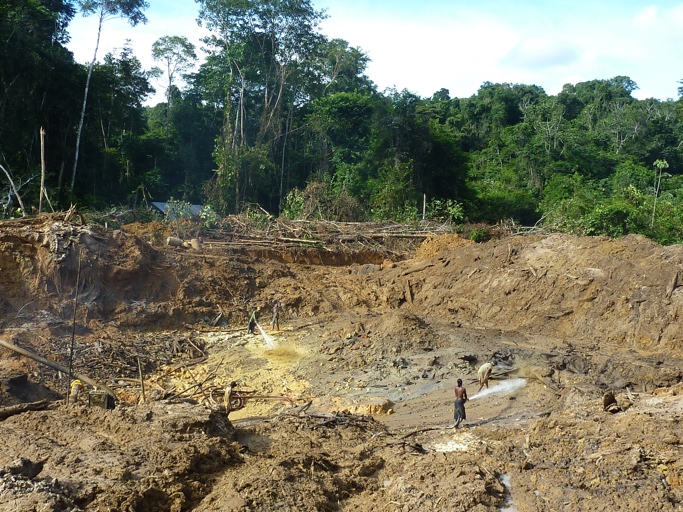Canadian Exploitation in the Mines of Guyana

Guyana’s large stock of natural resources has not only attracted Canadian mining companies, but also waves of unwelcomed corruption. Like much of the continent, this South American country endured a bitter past of European colonialism, followed by years of social strife and economic inequality. The majority of Guyana’s population is descended from African slaves brought to work on the sugar plantations (by the British and Dutch), as well as from indentured agricultural laborers brought from India after slavery’s abolition. [1] This ancestral divergence is still in evidence, as the two main political parties are both ethnically and racially based, causing frequent tension and instability in governance and civil society. Compounding these problems of ethnic and political division is the devaluation of what was once the country’s main export crop—sugarcane. The falling price of sugar in recent years has forced Guyana to invest more heavily in extractive industries, such as timber, minerals, and metals. [2] These resources are located predominantly in the interior regions of the country, home to the majority of the country’s indigenous population (now roughly 10 percent of the total population). The plight of the indigenous Guyanese, often referred to as “Amerindians,” has brought a new set of challenges to already difficult conditions, which have been historically aggravated by disputes over land titles, political marginalization, obsolescence of traditional job skills, and rapidly shifting cultural values. [3]
Regardless of the country’s political instability, foreign corporations have migrated to Guyana, attracted by the country’s vast extractive resource wealth. Among the foreign investors are more than 25 North American companies, seeking to take advantage of Guyana’s mineral wealth, minimal commercial taxes, and weak central government. The lack of economic regulation has converted Guyana into an international hotspot, as is illustrated by the 17.2 percent increase of foreign direct investment in Guyana in 2010. [4] Moreover, one third of this surge in foreign investment has been directed towards mining. Of the minerals, gold is the most prized resource and is being heavily extracted by such Canadian firms as Cambior and Guyana Goldfields, Inc. Among Guyana’s leading export goods in 2011, gold accounted for 45 percent of the country’s total export earnings. [5] Furthermore, the current output of gold is expected to increase significantly, particularly due to the ongoing development of Guyana Goldfields Aurora project, a massive mine, which once completed, will double the country’s current gold production.
The heavy interest of foreign multinationals in Guyana’s natural resources is not surprising, as the unstable and corrupt political environment presents an attractive opportunity for foreign firms looking to take advantage of the country’s rotting political and economic institutions. According to Transparency International’s 2012 Corruption Perceptions Index (CPI), Guyana currently ranks 133 out of 176 countries (with 176 making up the most corrupt public sector). [6] The majority of this corruption is the product of decades-long dependence on foreign capital and restrictive macroeconomic policies, as well as governmental inefficiencies and an ethnically divided society. Recognizing these vulnerabilities, foreign mining companies (particularly corporations based in Canada) have placed immense pressure on local governments to disregard tributary and environmental regulations. The greatest cost created by Guyana’s corruption is evident in the loss of untaxed revenue from foreign corporations, with up to 80 percent of potential gold revenue escaping through the country’s portals. [7] Often these foreign mining corporations use their capital as leverage to take over enormously resource rich, but politically weak states, such as Guyana, to extract huge quantities of natural resources at little or no cost.
Corruption in the mining industry is not simply restricted to Guyana’s borders, but is also present on Canadian soil. As Transparency International’s CPI indicates, Canada’s ranking has dropped from sixth in 2010 to ninth in 2012 (a score of “0” means a country is corruption free), as well as from first to sixth place in another Transparency International survey concerning honesty. [8] However, this favorable CPI ranking does not account for the fact that most Canadian mining corporations operate in countries more prone to corruption, partially due to the high level of governmental protectionism maintained on its domestic mining industry. [9] Adding to the Canadian government’s extreme regulation, are the multiple obstacles foreigners face in the Canadian legal system, where it is nearly impossible for foreign citizens to bring lawsuits involving egregious environmental and human rights violations in Canadian courts. The majority of foreign allegations brought against Canadian companies have been assigned to the host country’s criminal justice system, where they are often prosecuted under much more lenient regulatory standards. For example, in 1997 a lawsuit was filed by Guyanese villagers against Cambior Corporation regarding the Canadian corporation’s negligence surrounding a dam break disaster along the Omai River. This catastrophe resulted in mass contamination and fatalities. [9] The Quebec court refused to hear the case, claiming it did not have jurisdiction and subsequently passed the lawsuit on to the Guyanese judiciary. The case was then promptly dismissed without any repercussions other than ordering Cambior to pay the villagers’ legal fees. Unfortunately, these fines did not resolve the widespread destruction or necessarily help the Guyana government to implement changes in its economic infrastructure or provide good governance models.

Child labor is also a widespread problem within the Guyanese mining industry. Most recently, an eight-year-old child was found laboring in a gold mine in the Puruni region, near the Venezuelan border. [10] Unfortunately, this shocking case is not unique, as a report issued by the U.S. Department of Labor indicated that more than 44,000 children under the age of 14 are currently working in Guyana (where the legal working age is 15), and many of those underaged workers can be found in the mines. [11] Compounding this problem further, entire families have been forced to relocate to mining regions in order to find work. These migrations also fuel some of the problems of child labor as many young girls are often forced into prostitution in order to service the mining camps. As the 2011 U.S. Department of Labor report suggests, “Commercial exploitation is a problem in Guyana, including instances of forced prostitution.” This report further explains that there are “girls as young as age 12 working as prostitutes.” [12] Child labor in Guyana is one of the most shocking and abhorrent manifestations of the present Guyanese government’s fundamental lack of commitment to effective law enforcement and child protection.
During the last week of January, indigenous groups lost a crucial court case filed against mining companies, when Guyanese High Court decided that they do not have the right to expel miners from their lands. The Isseneru community, located in the western part of Guyana’s Amazon, responded saying, “We feel that when the High Court tells us that we have no rights to decide and control what takes place on our land, then the land is not ours… Just Friday, when inquiring at the office of the GGMC [Guyana Geology and Mines Commission], we learnt that our whole land is covered with mining concessions. Yet, the government has not informed us about this.” [13] This court decision not only heavily portends further deforestation, river dredging and water contamination, but also severely threatens the indigenous population’s already low standard of living. It constitutes an attack on their right to self-determination. Although in July 2012 Guyana’s Ministry of Natural Resources and the Environment announced the suspension of all new mining permits, it has not revoked old permits. [14] This is a clear violation of the 1978 Amerindian Act, which was supposed to return land titles to indigenous groups. Nevertheless, the problem has been that most of the affected communities were never informed of the availability of land titling, allowing foreign corporations to take over and continue mining.
Canadian corporations operating in Guyana have repeatedly demonstrated a total disregard for good governance, human rights and environmental conservation in the small country. These multinational firms have taken advantage of the absence of governmental oversight of the mining industry, which has contributed to the rampantly growing problems of child labor and prostitution. The Guyanese government will have to seriously increase the management oversight of its mining and public sectors. It remains to be seen, however, whether it will be able to do this on its own or require assistance from other intergovernmental organizations, such as the United Nations or the Inter-American Development Bank. Although heightened supervisory procedures will certainly cause foreign direct investment to decline, they will assure that a greater share of export revenues are likely to be reinvested to improve the country’s infrastructure, as well as promote desperately needed social welfare reforms.
John Milesi and Kimberly Bullard, Research Associates at the Council on Hemispheric Affairs
Please accept this article as a free contribution from COHA, but if re-posting, please afford authorial and institutional attribution. Exclusive rights can be negotiated.
For additional news or analysis on Latin America, please go to: LatinNews.com
References
[1] “Country profile: Guyana,” BBC News, last modified August 16, 2012, http://news.bbc.co.uk/2/hi/americas/country_profiles/1211325.stm.
[2] “Country profile: Guyana,” BBC News, last modified August 16, 2012, http://news.bbc.co.uk/2/hi/americas/country_profiles/1211325.stm.
[3] “World Directory of Minorities and Indigenous Peoples – Guyana: Indigneous Peoples,” Minority Rights Group International, 2008, last accessed 14 February 2013, http://www.unhcr.org/refworld/country,,MRGI,,GUY,,49749d16c,0.html.
[4] “Relations with Guyana,” Bureau of Western Hemisphere Affairs, U.S. Department of State, last modified July 9, 2012, http://www.state.gov/r/pa/ei/bgn/1984.htm.
[5] Ibid.
[6] “Corruption Perceptions Index 2012,” Transparency International, last accessed February 22, 2013, http://www.transparency.org/cpi2012/results.
[7] Chêne, Marie, Transparency International, “Overview of corruption and anti-corruption in Guyana, with reference to natural resource sectors,” Anti-Corruption Resource Center, February 26, 2010, http://www.u4.no/publications/overview-of-corruption-and-anti-corruption-in-guyana-with-reference-to-natural-resource-sectors/
[8] “Corruption Perceptions Index 2012,” Transparency International, last accessed February 22, 2013, http://www.transparency.org/cpi2012/results.
[9] “Courting Justice: Victims of mining abuses sue in Canada,” Mining Watch Canada, last modified February 11, 2012, http://www.miningwatch.ca/article/courting-justice-victims-mining-abuses-sue-canada.
[10] The Associated Press, “NGO says it rescued child ‘no older than 8’ from remote Guyana gold mining camp,” Fox News, November 5, 2012, http://www.foxnews.com/world/2012/11/05/ngo-says-it-rescued-child-no-older-than-8-from-remote-guyana-gold-mining-camp/#ixzz2K2obIXZX.
[11] Ibid.
[12] “US report says Guyanese children are engaged in mining, prostitution,” The Daily Herald, September 29, 2012, http://www.thedailyherald.com/regional/2-news/31979-us-report-says-guyanese-children-are-engaged-in-mining-prostitution-.html
[13] Hance, Jeremy, “Miners win ruling over indigenous groups in Guyana,” Mongabay.com, January 29, 2013, http://news.mongabay.com/2013/0129-hance-mining-guyana.html.
[14] Edmonds, Kevin, “Everything That Glitters Isn’t Green In Guyana,” Nacla, July 13, 2012, https://nacla.org/blog/2012/7/13/everything-glitters-isn’t-green-guyana.

